Sunroofs let in heat, glare, and harmful UV rays. This can make driving uncomfortable and damage your car’s interior. Tinting your sunroof solves these issues. It keeps your car cooler, protects against UV rays, and adds privacy without breaking the law. Learn the benefits, costs and legal limits for sunroof tinting.
Why Tint Your Sunroof?
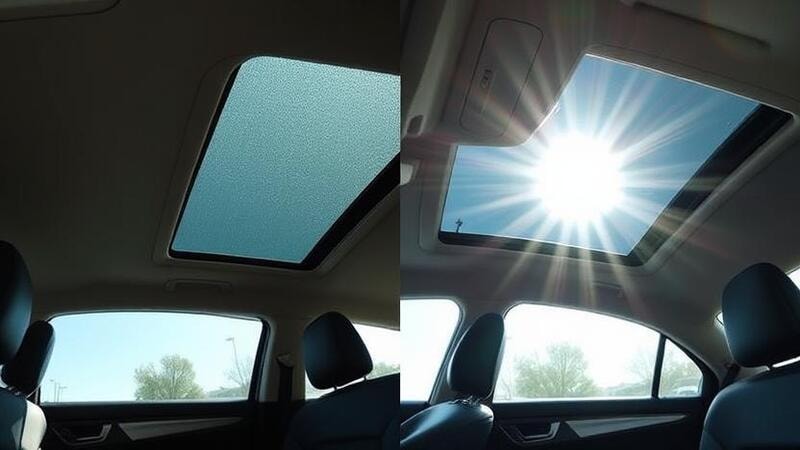
A sunroof brightens your drive but also brings unwanted heat and UV exposure. The sunroof is made of tempered glass. Tinting it solves these issues while enhancing comfort and protection.
By regulating cabin temperature, you won’t need to blast the AC as often. Passengers stay safe from UV exposure, and your car’s interior stays in better condition, helping it hold its value. Plus, it reduces eye strain from harsh overhead light.
Benefits of Tinting Sunroofs
A tinted sunroof does more than just look good. It blocks heat, protects your interior from harmful UV, and makes driving safer. You’ll stay cooler and save energy, too. Some of the benefits of tinting windows and sunroofs are described.
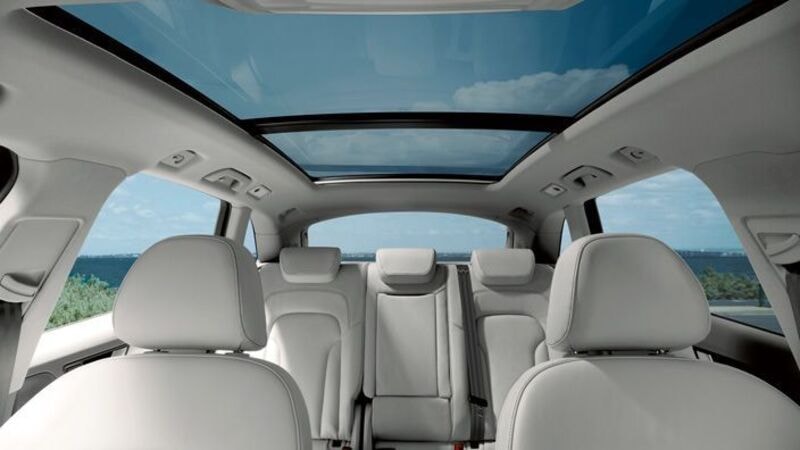
Sunroof glass is usually 4–6 mm thick tempered glass and already absorbs some UV. However, factory glass only blocks around 60–70% of UV rays.
With a premium sunroof tint, UV blockage rises to 99%+, while infrared rejection can reach up to 95%, keeping cabins 10–20°F cooler on hot days.
UV rays fade and crack leather, dashboards, and upholstery over time. A quality tint acts like sunscreen for your car’s interior. This helps maintain your vehicle’s value and appearance.
Bright sunlight through a sunroof creates distracting glare. Tinting cuts this glare significantly. This makes driving safer and more comfortable, especially during sunrise/sunset.

Studies show that reducing cabin temperature by just 10°F can lower AC usage by 20–30%. For gas cars, that means better fuel economy, while EVs gain an estimated 5–7% range extension in hot weather.
Types of Window Tint Films for Sunroofs
Choosing the right window tint film makes all the difference for your sunroof. Each type offers unique benefits, from heat rejection to clarity. Your budget, needs, and vehicle type will determine the best option for you.
Dyed Film

Dyed film is the most affordable option for sunroof tinting. It uses layers of dye to absorb heat and reduce glare. While it helps with basic heat reduction, it’s less effective than premium films.
The dye may fade over time, especially in harsh sunlight. However, it’s a good choice for budget-conscious drivers who still want some protection.
Metallic Film
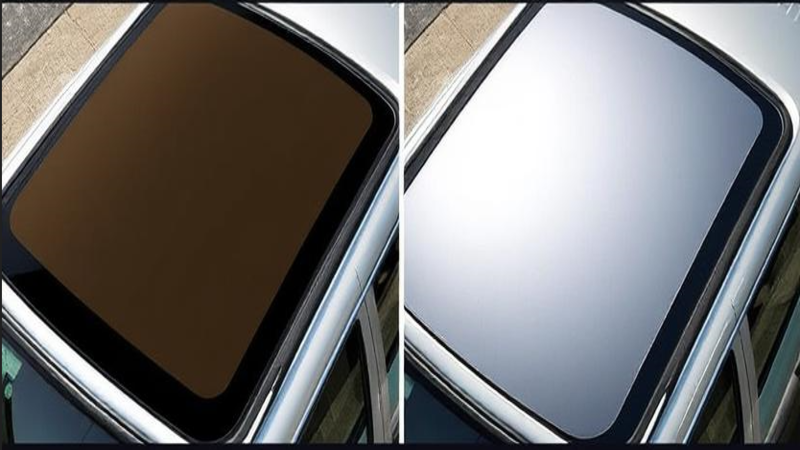
Metallic film contains tiny metal particles that reflect heat and UV rays. It’s more durable and practical than dyed film, keeping your car cooler. However, the metal can interfere with GPS, phone signals, and radio reception.
It also has a shiny, reflective appearance that some drivers dislike. This film works well for those who prioritize heat rejection over tech compatibility.
Carbon Film

Carbon window tint film offers strong heat rejection without signal interference. It’s made with carbon particles, which block infrared rays and reduce glare. The matte finish gives a sleek, non-reflective look.
It’s more expensive than dyed film but lasts longer and performs better. This is a great middle-ground option for balance and durability.
Ceramic Film

Ceramic window tint film is the top-tier choice for sunroof tinting. It uses ceramic nanoparticles to block UV and infrared rays without affecting signals. It provides superior clarity, heat rejection, and long-term durability.
Though the most expensive, it’s worth the investment for maximum protection and comfort. Ideal for those who want the best performance.
Special Notes for Panoramic Roofs
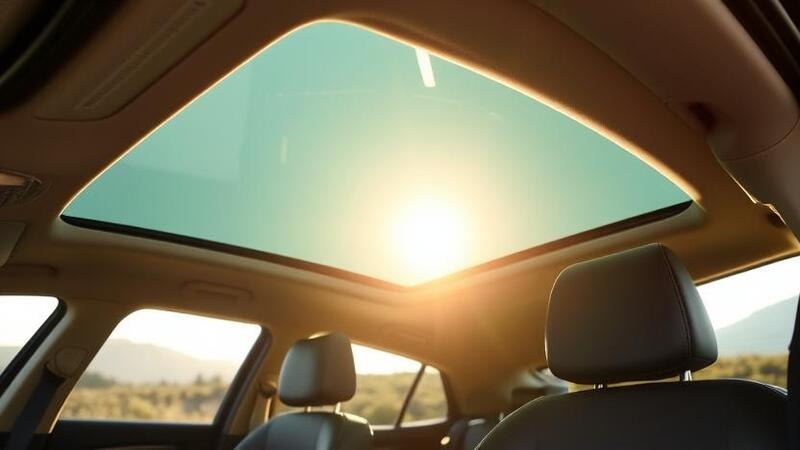
Due to their size and curvature, panoramic sunroofs need extra care. Ceramic or carbon films are best for even heat distribution and UV protection.
Ensure professionals install the film to avoid bubbling or peeling. Some vehicles may need a lighter tint to maintain structural integrity. Always check manufacturer guidelines before tinting.
Car Sunroof Tinting Options
When considering sunroof tinting, your choice of tint shade should match your local climate. Darker tint films (5%, 20%, 35%) absorb and retain more heat, making them ideal for cooler regions where extra warmth is welcome.
Lighter tints (30%, 50%, 70%) reflect sunlight better and are perfect for hot climates. Beyond temperature control, tinting offers excellent UV protection. This shields passengers and your car’s interior from sun damage.
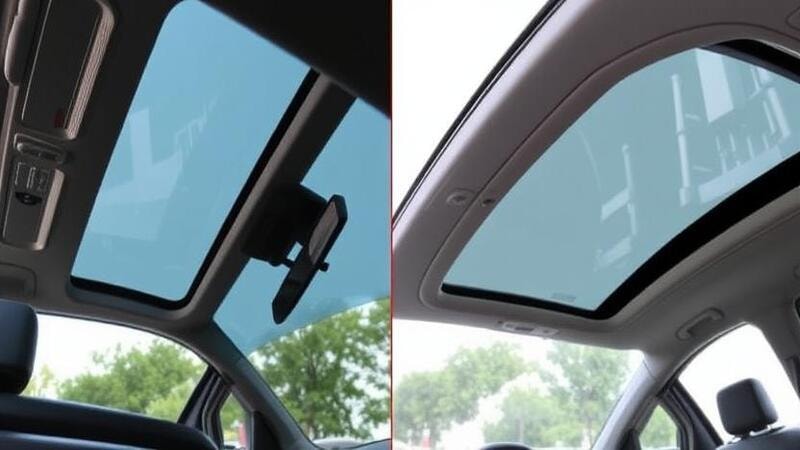
Several high-quality tint films are available on the market. Including cheap dyed films, high-performance carbon films, and premium ceramic options. That provides superior heat rejection. Each type comes in different shades to match your needs and preferences.
While DIY kits exist, professional installation is recommended. This ensures proper adhesion, avoids bubbles or peeling, and maximizes the tint’s lifespan. A well-installed tint performs better and maintains your vehicle’s sleek appearance.
Best Sunroof Tint for Heat and UV Protection
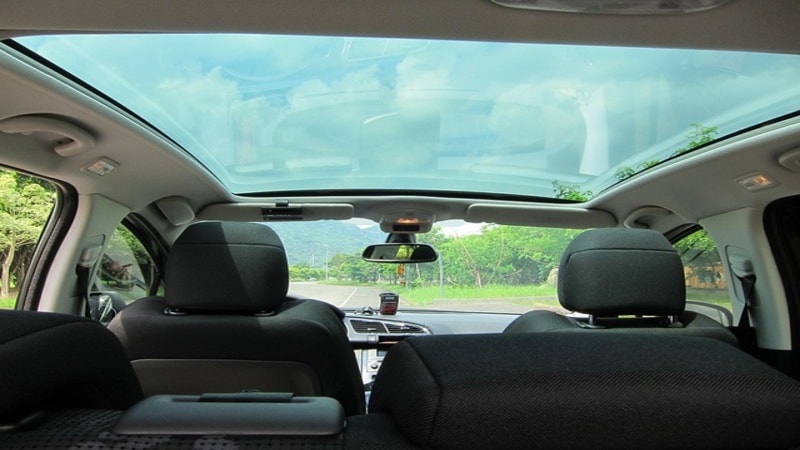
For superior protection, ceramic tint is the best option. Its advanced technology blocks up to 99% of UV rays while rejecting infrared heat, keeping your car noticeably cooler. Ceramic tint maintains excellent clarity without interfering with visibility or electronic signals.
Multi-layered films with infrared (IR) rejection take performance a step further. These specialized tints target heat radiation at multiple levels. Ultimately, providing exceptional temperature control even in extreme sunlight. They work particularly well for sunroofs, where heat buildup tends to be most intense.
Is Sunroof Tinting Legal? Laws and Regulations Explained

Sunroof tinting regulations in the U.S. focus on Visible Light Transmission percentages. They measure how much light passes through tinted glass. While most states don’t impose restrictions on sunroofs (considered non-windshield glass), laws vary.
Some states (like California and New York) regulate front and rear window tinting. But exempt sunroofs, while others (e.g., Texas) may have broader rules. Always verify local laws. The DOT (Department of Transportation)doesn’t restrict sunroof tints. Yet mandates safety glass standards (ANSI Z26.1) to prevent shattering.
Many states need tint films to carry AS-1 certification or manufacturer labels proving compliance. Inspections may check for proper labeling. Certain states allow darker tints with a physician’s note for light sensitivity conditions.
For panoramic roofs, ensure tints don’t violate glazing material rules. Some states ban reflective/metallic films that could distract other drivers.
How to Tint Your Sunroof

Tinting the sunroof can improve your driving comfort by reducing heat and glare. While ambitious DIYers can attempt the project, professional installation typically yields superior results. The process requires careful preparation and execution to avoid imperfections.
Remove the window tint glue before changing the window film.
Follow these key steps for proper sunroof tint installation.
- Clean the sunroof glass to remove all dirt, fingerprints, and residue. That could interfere with adhesion.
- Measure and cut the tint film to match your sunroof’s exact dimensions before removing the protective liner.
- Apply the adhesive side of the film to the interior glass surface. At the same time, keep it moist with the application solution.
- Use a squeegee to remove air bubbles and excess liquid. Work from the center outward in smooth strokes.

- Trim any excess film carefully along the edges using a sharp utility knife for a perfect fit.
- Keep the sunroof closed for 48-72 hours as the adhesive sets to allow the tint to cure completely.
- Consider professional installation for guaranteed results, especially with complex panoramic sunroofs or premium ceramic films.
Importance of Professional Installation
While DIY sunroof tinting may seem cost-effective, professional installation ensures superior, lasting results. Experienced installers perfectly fit the film to your sunroof’s unique curvature. Eliminating bubbles, wrinkles, and peeling that commonly plague amateur attempts.

They can also recommend the ideal tint material and darkness level. Based on your climate, vehicle type, and personal preferences.
Professionals use precision techniques to achieve seamless edges and proper adhesion. Their work often comes with warranties that protect your investment. This is for complex installations, especially on panoramic sunroofs or vehicles with advanced glass technology.
Expert installation becomes even more critical to maintain safety features and prevent damage. The peace of mind and long-term benefits make professional tinting services worth it.
Maintenance and Care of Tinted Sunroofs
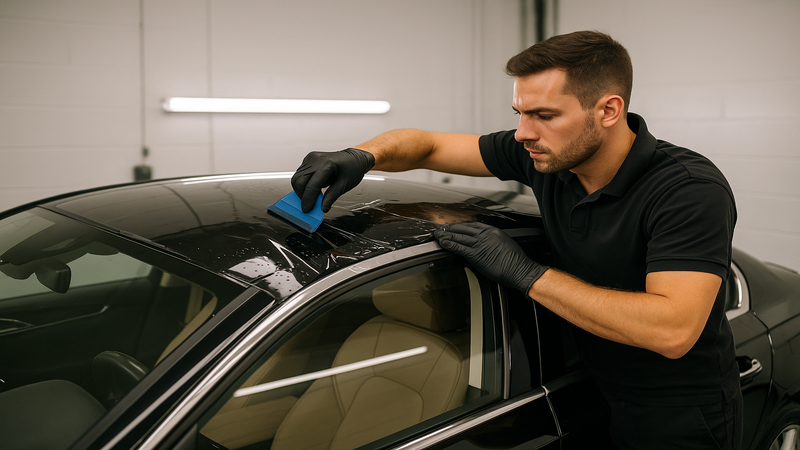
Proper maintenance is crucial. This is to preserve the appearance and functionality of your factory-tinted glass. Regularly clean with a mild, ammonia-free glass cleaner and a soft microfiber cloth. This will help prevent dirt buildup and maintain clarity.
Avoid harsh chemicals, tools, or rough scrubbing, as these can cause premature fading. Inspect the tint periodically for signs of peeling, bubbling, or discoloration. Such signs indicate the need for repair or replacement.
When opening or closing the sunroof, ensure the seals are clean and free of debris to prevent unnecessary friction on the tint film.
For best results, consult your tint installer for specific care recommendations. Every film needs tailored care. Consider professional services for any significant repairs or replacements. With proper care, your sunroof tint can provide lasting protection and performance.
Panoramic Sunroof Considerations
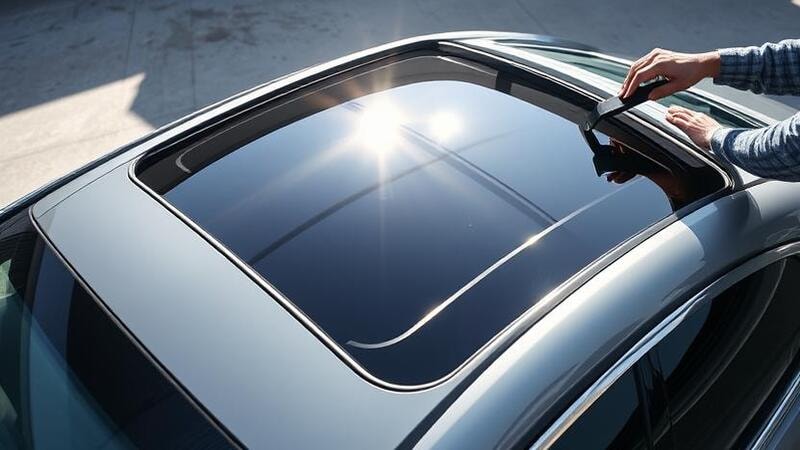
Tinting a panoramic sunroof presents unique challenges and opportunities compared to standard sunroofs. Due to their expansive size and complex curvature, panoramic roofs require special attention. This will ensure proper film adhesion and seamless coverage.
The larger glass surface area also means more heat and UV exposure. Making high-performance tint selection particularly important. Professional installers use specialized techniques to handle the extended dimensions and subtle curves. These characteristics characterise these sophisticated sunroof systems.
Choosing the ideal tint involves evaluating several vehicle-specific factors. The glass composition, existing factory tint, and structural design vary between models. What works for a Mercedes panoramic roof may differ from a Honda’s system.
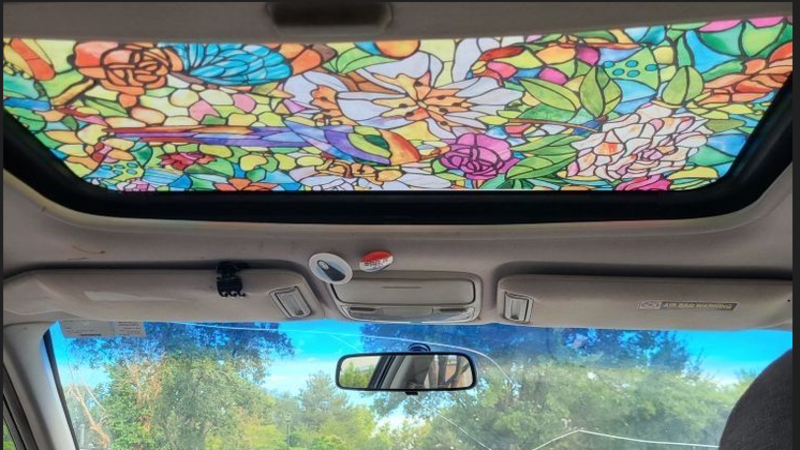
Climate plays a role, too. Drivers in sunnier regions might prioritize maximum heat rejection. In comparison, drivers in cooler areas could focus on UV protection. Personal preferences regarding visibility, reflectivity, and interior ambiance influence the decision.
When properly executed, panoramic sunroof tinting delivers exceptional benefits. The extensive glass coverage means quality tinting can reduce cabin temperatures. Sometimes by 15-20 degrees Fahrenheit.
It provides comprehensive UV protection for all passengers. Further, it helps prevent the risk of skin cancer and interior fading.
The reduction in glare is especially noticeable across the broad glass surface. This ultimately enhances visibility and driving comfort. Many owners also appreciate how tinting gives their panoramic roof a more premium appearance. While maintaining the open, airy feel of the original design.
How Much Does Sunroof Tinting Cost?

The cost of sunroof tinting varies based on several key factors. Standard sunroofs typically range from $100 to $300, while panoramic sunroofs may cost $250 to $900 due to their size and complexity. The price fluctuates depending on:
- Film Material
- Dyed film: $50–$150 (budget option)
- Carbon film: $150–$300 (mid-range performance)
- Ceramic film: $250–$600 (premium heat/UV protection)
- Installation Type
- DIY kits may seem affordable, but they risk bubbles/peeling
- Professional installation ensures precision and often includes warranties
- Vehicle Factors
- Curved glass or complex shapes (e.g., Tesla panoramic roofs) may increase labor costs
- Existing tint removal adds $50–$150
| Option | Price Range | Best For |
|---|---|---|
| DIY Tint Kit | $30–$100 | Budget seekers, small sunroofs |
| Professional Dyed | $100–$200 | Basic heat reduction |
| Professional Ceramic | $250–$600 | Maximum heat/UV rejection |
The costs mentioned are approximate estimates and may vary based on your vehicle and location. Contact our experts today for exact pricing tailored to your sunroof size and preferred tint film.
FAQs
Q1: Is tinting your sunroof worth it?
Yes, tinting your sunroof is worth it. It reduces heat, blocks harmful UV rays, minimizes glare, and enhances privacy. In comparison, protecting your car’s interior from fading.
Q2: Can I get wholesale pricing for bulk orders of ceramic or IR-rejection tint films?
Absolutely. Carlike offers competitive bulk pricing and dealer-exclusive rates for B2B partners. Contact our sales team for a customized quote based on volume and film type.
Q3: Do your films comply with DOT or local tinting regulations?
Yes, our quality tint films meet DOT safety standards (ANSI Z26.1) and are available with certifications or labels required by state laws. Always confirm local compliance before installation.
Conclusion
Sunroof tinting is a must-have upgrade for car owners who want to beat the heat, block harmful UV rays, and drive comfortably, especially in sunny climates. Whether you’re a DIY enthusiast or prefer professional results, the right tint transforms your sunroof from a glare source to a comfort feature.
Panoramic roof owners gain even greater benefits with improved temperature control. Ready to enhance your ride? Get your sunroof tinted today and feel the difference!
Maximize Your Profit with Carlike’s Sunroof Tinting Films
Upgrade your auto business with CarlikeFilm’s premium sunroof tinting solutions to maximize your shop’s profitability. Our high-performance ceramic, carbon, and IR-rejecting films allow you to offer superior heat and UV protection, creating new upsell opportunities for every customer.
Partner with us to access exclusive dealer benefits. Contact our B2B team today to discuss bulk pricing and grow your tinting revenue!



